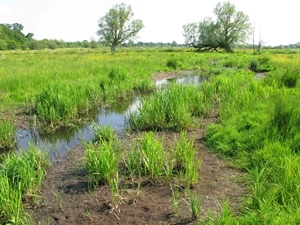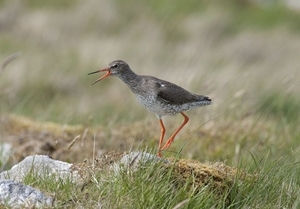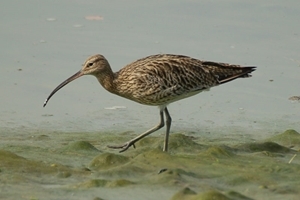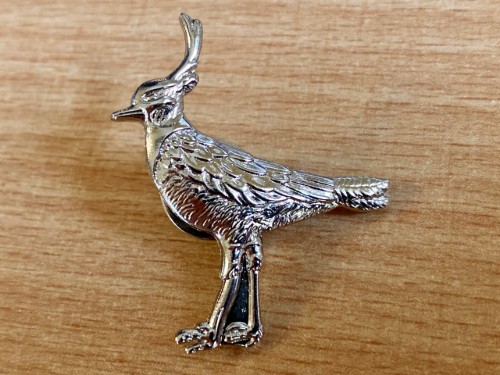Key points
- This paper repeated a national survey of breeding waders first carried out in 1982.
- Significant decreases were found for lapwing, snipe, curlew and redshank, with increased numbers of oystercatcher.
- Loss of habitat because of land drainage, conversion to arable farming from pasture, and more intensive grazing and hay or silage production techniques has contributed to declines.
- The remaining waders tend to be aggregated in a small number of sites, with designation appearing important.
Background
 Lowland wet grassland provides significant breeding habitat for important populations of several wader species. However, large areas of this habitat have been lost in recent decades because of drainage for agriculture, with a switch to arable cropping and more intensive farming techniques. One estimate suggests that around 20,000 square kilometres of wet grassland were lost between 1940 and 1980.
Lowland wet grassland provides significant breeding habitat for important populations of several wader species. However, large areas of this habitat have been lost in recent decades because of drainage for agriculture, with a switch to arable cropping and more intensive farming techniques. One estimate suggests that around 20,000 square kilometres of wet grassland were lost between 1940 and 1980.
In 1982, the first systematic national survey of breeding waders was carried out on the remaining lowland wet grassland across England and Wales, which aimed to identify all areas of this important habitat and survey the breeding waders found there. Further declines were thought to have occurred, so this study repeated the 1982 survey to identify how numbers had changed.
What they did
Using the same methods as in the 1982 survey, over 1,000 lowland wet grassland sites were visited three times between April and June in 2002. Surveys were carried out by both trained volunteers and ecologists, who searched the whole area of a site, walking to within 100m of the entire area and recording the total number of lapwing, snipe, curlew, redshank and oystercatcher observed as well as estimating the number of breeding pairs present. The surveyors also noted the land use that was present on each site, recording the proportions of hay, silage, sheep or cattle grazing, arable or other.
The analysis methods used were the same and the results were compared to those obtained in 1982.
What they found
 Lapwing were the most numerous wader recorded, with 5,387 pairs accounting for over half of the total number of waders observed. They were present throughout England and Wales, but their distribution was patchy, with high numbers concentrated into a small number of key areas.
Lapwing were the most numerous wader recorded, with 5,387 pairs accounting for over half of the total number of waders observed. They were present throughout England and Wales, but their distribution was patchy, with high numbers concentrated into a small number of key areas.
Redshank were second most numerous at 2,452 pairs, being found mainly in East Anglia, north Kent and areas of northern England.
Oystercatcher were third most numerous with 967 pairs, found in northwest and eastern England.
These were followed by snipe, with 570 pairs concentrated mostly in east England. 441 pairs of curlew were recorded, mainly in the north and west. Breeding waders were virtually extinct from Wales, and to a lesser extent the southwest of England.
These numbers and the change compared to 1982 was as follows:
| Species |
Number of pairs 2002 |
Change |
| Lapwing |
5,387 |
37% decrease |
| Redshank |
2,452 |
29% decrease |
| Oystercatcher |
967 |
47% increase |
| Snipe |
570 |
62% decrease |
| Curlew |
441 |
40% decrease |
For more information, including details of number of pairs in different areas as well as the confidence limits that are attached to these figures, please see the paper.
What does this mean?
 Four of the five species have declined significantly over the 20 years between surveys. These large decreases are because of both smaller numbers on sites that are still occupied, but also because of the complete loss of the species in certain areas. This pattern was most pronounced for snipe, which were present on almost a third of sites surveyed in 1982, but only on 8% of those surveyed in 2002. Wader populations are becoming more aggregated, with patchier distributions making them less resilient to future environmental change. Again, this was found most markedly for snipe, with 90% of breeding snipe found on just 3% of the wet meadows surveyed in 2002.
Four of the five species have declined significantly over the 20 years between surveys. These large decreases are because of both smaller numbers on sites that are still occupied, but also because of the complete loss of the species in certain areas. This pattern was most pronounced for snipe, which were present on almost a third of sites surveyed in 1982, but only on 8% of those surveyed in 2002. Wader populations are becoming more aggregated, with patchier distributions making them less resilient to future environmental change. Again, this was found most markedly for snipe, with 90% of breeding snipe found on just 3% of the wet meadows surveyed in 2002.
This study also found that wader populations tend to be higher, and have declined less, in designated areas (ESAs, SSSIs or nature reserves), than in the wider countryside. However, the paper concludes the management that is typical in nature reserves is not practical across the wider landscape, and reserves alone will not be able to support national populations of wet grassland birds. The authors suggest that successful management methods that can support waders should be integrated more into agri-environment scheme options, and that the effect of these should be evaluated.
More recently, a study looked at the effect of agri-environment schemes and site protection (for example SSSI/nature reserve) for breeding waders. This found that both approaches can benefit waders, but the combination of both together on the same site can have the largest positive effect for the conservation of waders on lowland wet grasslands.
Read the original paper
Andrew M. Wilson, Juliet A. Vickery, Andrew Brown, Rowena H.W. Langston, David Smallshire, Simon Wotton & Des Vanhinsbergh (2005) Changes in the numbers of breeding waders on lowland wet grasslands in England and Wales between 1982 and 2002, Bird Study, 52:1, 55-69.
Photo credit: David Mason

Get your GWCT Lapwing Badge for £9.99
£5 from the sale of each badge goes directly to our Wader Tracking Appeal
You can support our biggest tracking project yet and help curlew, lapwing and woodcock with our brand new lapwing pin badge. £5 from the sale of each badge goes toward this vital project. Badge measures approx 3cm x 3.5cm.
View Badge >
or
Buy Now - £9.99 >
100% Secure. All Credit & Debit cards, PayPal, Apple Pay and Google Pay accepted.
